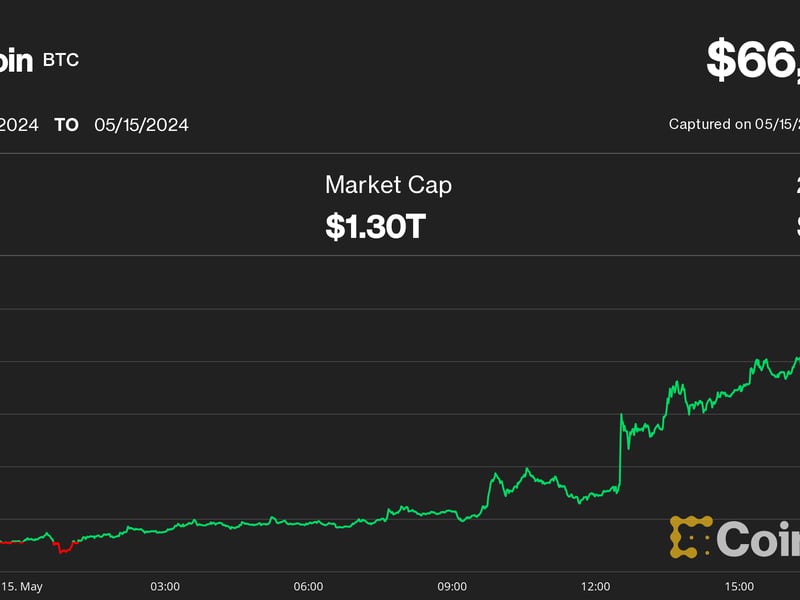The Fed Will Tell Us Soon If Bitcoin Is at a New Baseline
The anticipation of a Fed rate cut today in crypto and wider investment markets is palpable.
The decision could potentially be a substantial 50bps “statement of intent” cut (currently priced around a 60% likelihood). Such a move could show us where the new baseline for bitcoin – and consequently much more of the crypto market – now lies.
There’s a lot of noise in crypto markets at the moment, particularly around bitcoin. Traders are likely to react to the news of a Fed rate cut with some retrenchment, as short-term market dynamics filter out. This is particularly driven by investor concerns about the direction of travel of the U.S., and global, economy.
But let’s see the forest for the trees. Markets are always noisy in the short-term, so inflow and outflow trends over a short horizon should be taken with a significant pinch of salt. It is the longer-term implications of the narrative around easing monetary conditions that lend themselves to a fresh bull cycle for bitcoin, ether and the rest of the market.
In the past, bitcoin has correlated somewhat to major tech indices such as the Nasdaq. Looking at medium- and long-term trends, both have broadly moved in line with monetary conditions. In the past decade, this has been evermore the case as investors hunt for yield in lower-rate environments.
But this doesn’t always map perfectly. The recent all-time high (ATH) for bitcoin, for instance, was resolutely secular – i.e. it didn’t come in the wake of easing monetary conditions. The ATH happened in direct opposition to the generally accepted cyclicality of higher-risk assets such as bitcoin.
It is an understated fact that this counter-cyclical ATH is the first in the history of the world’s biggest crypto asset. This suggests that, once the market has shaken out the short-term volatility, we could be at a new baseline for the crypto asset, particularly as rate cuts now look set to power the market forward o.
What is critical from an investor point of view is that such assets are extremely forward-pricing. Money chases risk assets for the promise of future earnings. That means markets don’t necessarily react to diminishing economic circumstances. But they do tend to move (albeit more ponderously) as monetary conditions change.
This is what makes the rise this year of bitcoin to a new ATH even more notable. In effect, it is not doing what monetary policy conditions say it should be doing. So, what has happened? In short, ETFs have happened.
This non-cyclical, “secular” trend is likely driven by a major reallocation of capital that the arrival of ETFs has precipitated. In effect, the addition of ETF streams of income to bitcoin as an asset class have freed up enormous institutional and retail pools of capital looking for a home – irrespective of the monetary conditions.
As a result, the fundamentals of the market really do look different currently, and this could take investors into whole new frontiers in terms of price and adoption dynamics.
Obviously, nothing is ultimately guaranteed, but there is certainly something notable happening in the market that has not taken place before.
Remember crypto had, until 2022, never functioned inside a higher-rate environment. It has now had two years in that new phase.
TradFi capital shifts
Bitcoin isn’t the only crypto market that has experienced a secular run this year. Tokenized assets are booming as TradFi investors wake up to the potential of the market. With major underpinning assets such as bitcoin and ether driving the market and adoption, the opportunity for smaller projects as the “rising tide lifts all boats” is huge.
What is different now from past market cycles, which mirrors bitcoin, is the secular shift of TradFi capital. Again, this isn’t about growing an asset per se, it is about reallocating capital out of TradFi infrastructure and into digital on-chain environments.
This is a trend that is very much marking a shift away from the ‘crypto winter’ in 2022 that set in as rates rose. Infamous crypto projects in that era often collapsed thanks to a lack of fresh liquidity – in other words, ultimately to tightening monetary conditions.
Anecdotally, we’ve seen interest from a new wave of retail investors, with notable high-net-worth and institutional uptake too. ETFs have given these TradFi capital pools access at just the right moment in monetary terms, to adopt new opportunities, be they bitcoin, gold or equities.
Of course, this all comes with the caveat that the Fed might surprise us with a more conservative decision. But easing monetary conditions, when they finally arrive for certain, are only going to fan the flames of this expansion. This bodes well for the years ahead as the sector goes from strength to strength.
Note: The views expressed in this column are those of the author and do not necessarily reflect those of CoinDesk, Inc. or its owners and affiliates.
Disclosure
Please note that our
privacy policy,
terms of use,
cookies,
and
do not sell my personal information
has been updated
.
CoinDesk is an
award-winning
media outlet that covers the cryptocurrency industry. Its journalists abide by a
strict set of editorial policies.
In November 2023
, CoinDesk was acquired
by the Bullish group, owner of
Bullish,
a regulated, digital assets exchange. The Bullish group is majority-owned by
Block.one; both companies have
interests
in a variety of blockchain and digital asset businesses and significant holdings of digital assets, including bitcoin.
CoinDesk operates as an independent subsidiary with an editorial committee to protect journalistic independence. CoinDesk employees, including journalists, may receive options in the Bullish group as part of their compensation.
:format(jpg)/author-service-images-prod-us-east-1.publishing.aws.arc.pub/coindesk/23c91741-db54-498b-aed3-838da9f0184e.jpg)
Philipp Pieper is co-founder of tokenized assets platform Swarm Markets.









